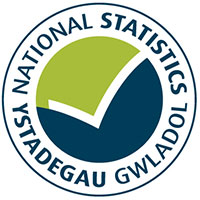Statistics on people registered to vote in parliamentary and local government elections as recorded in the electoral registers for 2018.
This is not the latest release in the series: Electoral roll
For Wales (and for England) electoral statistics are taken from data supplied to the Office for National Statistics by local Electoral Registration Officers.
Electoral statistics are annual counts of the number of people who are registered on electoral registers and so entitled to vote.
Main points
- The total number of parliamentary electors in Wales is 2,230,100; a decrease of 1.4% between 2017 and 2018.
- This is the first percentage decrease seen since the year to December 2015 when the number of electors decreased by 2%.
- In December 2017 the number of parliamentary electors was at its highest since December 2013 following three successive years with national polls. This is at least partly due to campaigns encouraging eligible voters to register being held across the country during the EU referendum in June 2016, and also for the May 2015 and June 2017 General Elections.
Electoral roll statistics are based on the parliamentary constituency boundaries and are published for both parliamentary and local government electors. Until 14 December 2011 parliamentary constituency boundaries were the same as those for Assembly constituencies. However The Parliamentary Constituencies and Assembly Regions (Wales) (Amendment) Order 2011 made changes to the National Assembly for Wales constituency and electoral regions boundaries so that the two are now different (see notes below).
Notes
The Parliamentary Constituencies and Assembly Regions (Wales) (Amendment) Order 2011 made changes to the National Assembly for Wales constituency boundaries and electoral regions as a result of local government boundary changes in six local authority areas. The Order did not make the same changes to the boundaries of the Parliamentary constituencies. The Order came into effect on 14 December 2011 so from this point onwards there are some differences between the Parliamentary constituencies and the National Assembly for Wales Constituencies.
Electoral rolls provide counts of the number of people registered to vote. It should be noted that the number of people eligible to vote is not the same as the resident population aged 18 and over. There are various reasons for this. For example, not everyone who is usually resident is entitled to vote (foreign citizens from outside of the European Union and Commonwealth, prisoners, etc. are not eligible), some people do not register to vote, and people who have more than one address may register in more than one place. Further, there is inevitably some double counting of the registered electorate as electoral registration officers vary in how quickly they remove people from the registers after they have moved away from an area or after they have died. These factors have a differential impact from area to area. This means care needs to be exercised when comparing population estimates with electoral roll.
As agreed with the Office for Statistics Regulation, these statistics will be updated at 12.30pm on the day of release by ONS.
Contact
Martin Parry
Telephone: 0300 025 0373
Email: stats.popcensus@gov.wales
Rydym yn croesawu galwadau a gohebiaeth yn Gymraeg / We welcome calls and correspondence in Welsh.

